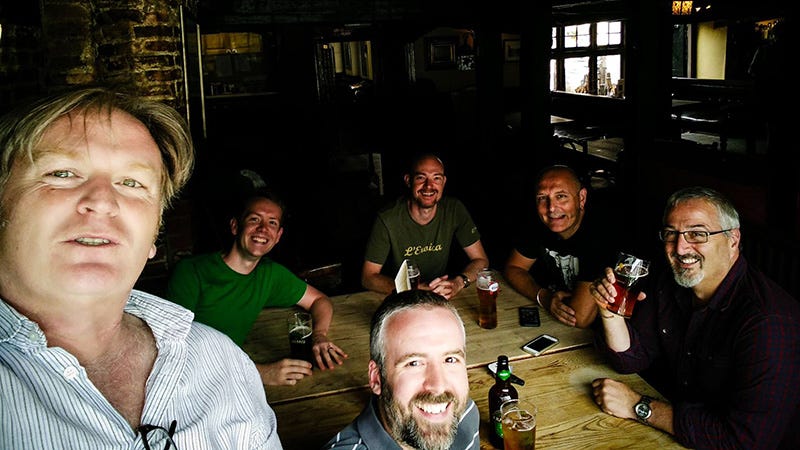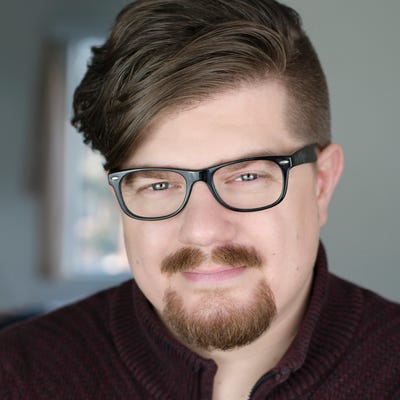How Two Point Studios carved its simulation game niche
Two Points Studios co-founders Mark Webley and Gary Carr, both veterans of Bullfrog and Lionhead Studios, share lessons on building a sustainable company in a niche genre.

How did Two Point Studios—the Sega-owned, Farnham-based simulation shop behind Two Point Hospital and Two Point Campus get its name?
Studio co-founders Mark Webley and Gary Carr had to think back a bit to answer that question. Ostensibly it's a reference to two-point perspective—a drawing style seen in architecture where lines converge at two vanishing points. It's not exactly an isometric viewpoint, but the pair say it's in the spirit of the camera perspective you find in the studio's simulation games.
But mainly it's a joke on Webley and Carr themselves. The two veterans of Peter Molyneux-led studios like Bullfrog Productions and Lionhead Studios have a bit of Statler and Waldorf energy about them—they'll spend conversations ragging on themselves and each other, quick to share their thoughts on game development, but equally quick to argue with each other before affirming what the other just said.
"Mark and I often have two very different points of view from each other, but often we're saying exactly the same thing," Carr joked. "He says it one way, I say it another way, but then everyone says 'no, you're saying the same thing guys, you're agreeing with each other!'"
It's the kind of joke that can only come from two friends and business partners whose first shipped game together was 1995's Hi-Octane on the Sega Saturn. They kept orbiting each other as they navigated a post-Bullfrog world. Webley helped found Lionhead while Carr went off to found Mucky Foot Productions. Carr would circle back to Lionhead, but the pair parted ways again when Webley left Lionhead in 2013.
The two men bonded over what they affectionately refer to not as simulation games, but "little people games"—games where players look down from a bird's eye view on simulated people living out their lives like in a moving diorama. So in 2016, they joined up with co-founder and technical director Ben Hymers to launch Two Point Studios and start work on Two Point Hospital: a spiritual successor to Theme Hospital the "little people game" that they'd first loved working on.

The Two Point Studios team gathers for lunch on the studio's very first day.
But for their first shared company without Molyneux at the helm, the pair knew there was another goal looming over them: that not only they build a space to make simulation games, but that they build the studio to be as sustainable as possible, and to avoid crunch culture.
Five years after the launch of Two Point Hospital, they've picked up a few lessons worth sharing with other developers. Maybe most importantly—they learned what it took not to replicate the harsh working conditions they endured at Bullfrog and Lionhead that kept developers away from their families on long periods of crunch.
What makes for a successful simulation game?
Building a studio that sticks to one genre of game has some key technical advantages—Carr and Webley noted that in their Bullfrog and Lionhead days, the companies kept changing what genres they were working in, so tools and design logic had to keep being rebuilt from scratch. But if you're sticking to one genre, you need a very clear idea of what makes that genre work.
Webley and Carr see their simulation games as joyful "plate-spinning" exercises that play out in sandbox environments. And they think of the word "sandbox" quite literally. They conjured the image of children sitting in play boxes with no set goal—just conjuring scenarios in their own minds with the help of construction tools or buckets for sandcastles.
Carr himself doesn't really enjoy games that focus on "win criteria" that block progression. "Our games don't really punish you," he noted. "They don't stop you from playing with them—they let you tinker with these little people and let you advance at whatever speed you wish to advance."
Webley noted that there's an interesting paradox with making lighthearted simulation games based on real-world environments. The Two-Point games were deliberately built with a cartoony "Simpsons Springfield" mindset that feels like it's everywhere and nowhere at once. That cartoon logic makes it easy to pull back from trying to simulate real-world hospitals or universities.
He remembered touring real hospitals while working at Bullfrog and realizing they could be very boring environments, and Carr pointed out that because they "knew nothing about the medical profession," they were at a loss for how to replicate the real process of treating diseases and injuries.

So with Two Point Hospital, as with Theme Hospital, they built those "spinning plates" and complex systems on the back of fake cartoon diseases that could be treated in colorful and complex environments. "That made us feel comfortable because we 'know' how to cure a bloaty head because you pop it, and inflate the head with something you pump a tire up with. Now you're in a safer place to actually build the simulation."
Of course, Webley noted that building so many spinning plates—the diseases, the cures, the special doctors you can hire, etc.—can be really fun at the start of development and become a great challenge towards the end. "Finishing a game like this is really, really hard," he said. There will be plenty of moments where a little change to the interlocking systems could break the game or lead to it not playing "right."
The pair also mused on how important it was for the aesthetic of the Two Point series to not ever feel locked in time. The company's business approach is that the Two Point titles need to feel fresh whether they're purchased on the day they launch or years after, especially when their target audience isn't necessarily a hardcore one looking for the latest-and-greatest graphics or gameplay innovations. "One of our biggest fans is a retired nurse who's in her 80s," Carr pointed out. She's been playing [Two Point Hospital] for five years...and she's communicating and playing with people who are significantly younger than her. They are playing probably in a different style, but everyone gets something out of it."
The pair described Two Point's style as "intentionally 'naive,' and almost very low-detail." Character models look a bit like toys, with skin and clothing materials that ride the line between simulating a person and simulating plastic—similar to how Aardman animation's house style has been to let the "clayness" of their stop-motion animation live on in the computer-generated era.

They agreed that compared to their time at Bullfrog, they get to spend more time on the creative side of game development. In the old days, they used to build completely new proprietary engines for each new game, meaning they never had time to "play with" the systems they were making or evolve the gameplay.
Comparing the tech challenges of Bullfrog versus Two Point led to an interesting conversation about the latter studio's company culture. Though the pair say they deliberately set out to create a better work-life balance at the new studio, it wasn't just a switch that could be flipped—it was made possible only by advances in technology and actively managing people not to overwork themselves.
Overcoming a history of crunch culture
It briefly felt a bit touch-and-go asking Webley and Carr about the crunch they endured in their younger days. The memories were made fresh by recent reporting about the development of Fable, which catalogued the highs (and very frustrating lows) of life at Lionhead. (Carr didn't work on main series but was a key leader on two spin-offs).
But in the end, the pair were very clear-eyed about how they worked and their responsibility in mandating that crunch. "We were as guilty of anybody of having to deal with people not being with their families," Carr recalled. "But we've not done any crunch [at Two Point Studios]."
Webley remembered that before anything else, he was willing to crunch extensively in his younger days because he'd come to the industry after a job programming accounting software. He remembered keeping normal hours at that job, but sought out the game industry for the thrill and excitement of making games.
He made a relevant note, which was that especially back in the industry's early days (before the internet helped spread knowledge of game development in a faster fashion), lots of workers might expect to find crunch or long hours in a number of professions, and might not know how painful that crunch can be in game development. "Accountants still crunch at the end of the financial year," he observed. "So it's not just our industry."
Carr remembered the crunch as being driven by Bullfrog's drive for "innovation." Obviously that drive to push the limits of what games could do helped keep people working late hours, but there was a subtle, more harmful impact of always trying new game mechanics. "We'd always be starting from scratch, and there was no kind of benefit of experience," he recalled. "We weren't standing on our own shoulders, because we'd moved on to a completely new direction [with each new game.]"
If you ask him how Two Point's managed to downplay crunch culture at the company, his first answer is "middleware." It used to be very difficult to estimate how long game production could take because tool production and game production often happened simultaneously. "You'd be working with software that wasn't robust. It would be 'crash and burn, start again, hopefully get some stability in time, and then when it's stable enough, hopefully build some quality into the game.'"
Newer industry tools like Unity and Unreal Engine have laid the foundation for Two Point to feel out exactly how long it will take to schedule game production—putting responsibility on Webley and Carr to actively not schedule crunch as best they can. They noted that some of their colleagues have worked late hours on occasion, but there's a general consensus that their employees are able to set their own hours—to start early if they want to spend time with their kids after getting home from school, or to start later if they're taking care of appointments during the day.

Gary and Mark lining up to be operated on by their employees.
The hope, the pair said, is that their employees can feel free to schedule that time themselves as needed, without feeling a need to beg for permission.
Webley also pointed out that post-launch DLC (both free and paid) takes some pressure off schedule planning in a way that didn't exist in the days of shipping only physical copies. "Once a game is shipped, we're not finished," he noted. "There might be quality-of-life things, something we've identified as a cool feature—we can do that once we've finished and not going 'that's it.'"
The pair described how their job has become a bit less about leading development and more about curating a team that can make the Two Point games. They said, that process spotlighted the need to "respect their [employees'] professionalism," and trust that if they hired people who shared the same vision, they'd manage their own schedules in a way that fits their lives.
Where is Two Point Studios headed next?
Carr and Webley always seem to find comedy when looking back on their professional history. For instance, Two Point Studios' unusual name became a calling card for the company's games partly because the developers remember what happened when they worked on Bullfrog's Theme Park. "If you Google "theme park...you're not going to find lots of screenshots of the game," Carr said with possibly the smallest amount of annoyance. "Having a quirky name does make you very search engine friendly."
That challenge speaks to how long the pair have been around the games industry—and how much change they've seen from making to selling games. They've also seen some supposed next-generation technology come and go, like Microsoft's motion-tracking Kinect, which makes them eager not to bet too big on "the future" of video games. They indicated that embracing "future technologies" is sometimes more trouble than it's worth and noted their development strategy "doesn't rely" on such advances.
What are they looking forward to? Webley eagerly pointed to Nintendo's anticipated successor to the Nintendo Switch, noting that the Switch itself was a major game-changer for their company. "They have the ability to just be completely differently than everyone else," he said. Carr agreed, noting that the Switch's audience of more "casual" gamers helped Two Point Studios balance the polar ends of their audience. Hardcore simulation strategy players will build massive Rube-Goldberg contraptions on PC, but casual players now have a more accessible platform to drop in and just enjoy the general vibes of running a hospital or university.
If the audiences that Nintendo and Two Point Studios are targeting continue to be aligned, that successor device will be a big part of the studio's upcoming games. Wherever they're at, they want to make sure they're in a business where everyone at the company feels like they're actually making games, not just making the individual parts that are assembled into a massive game.
Read more about:
FeaturesAbout the Author(s)
You May Also Like







.jpeg?width=700&auto=webp&quality=80&disable=upscale)








